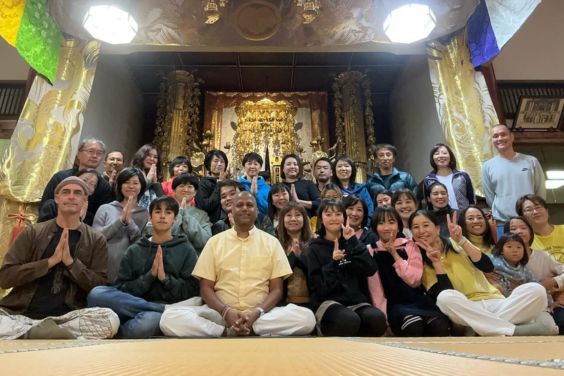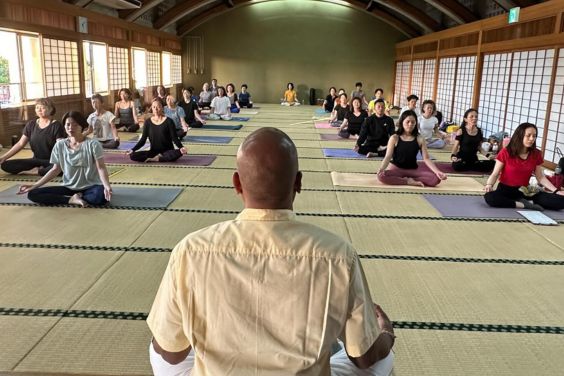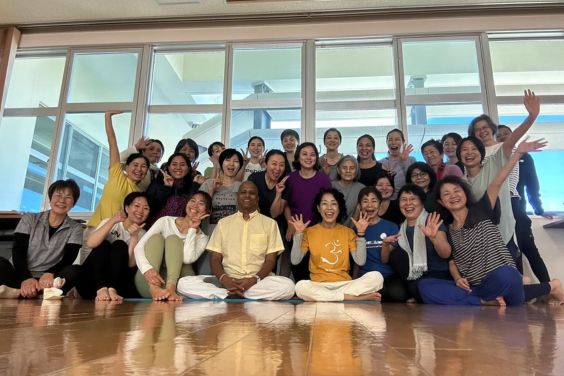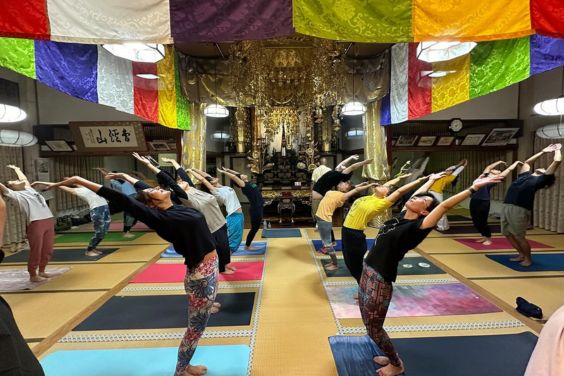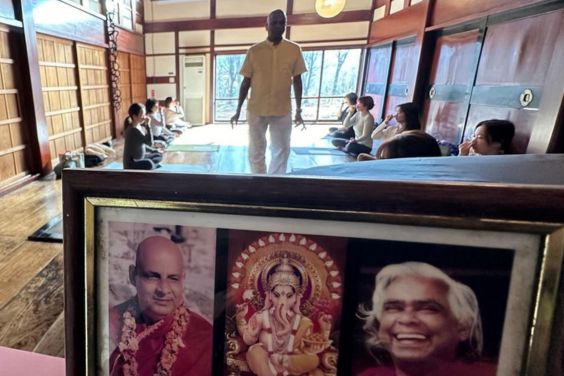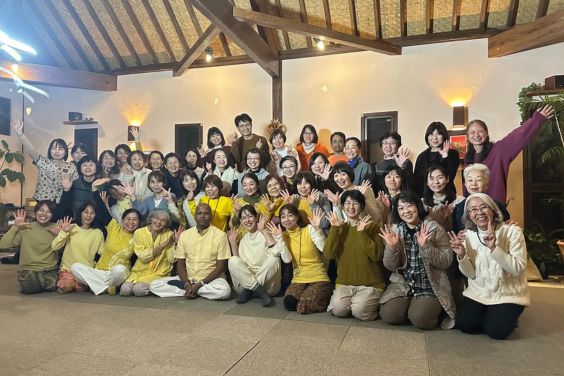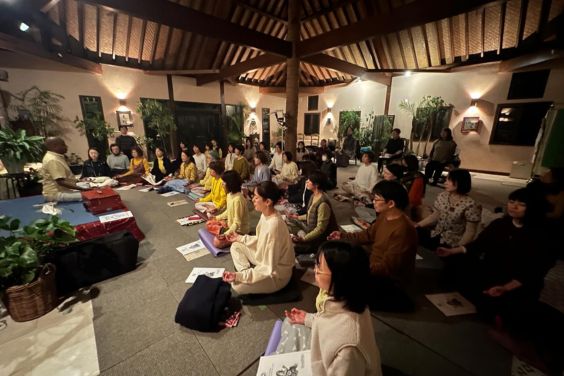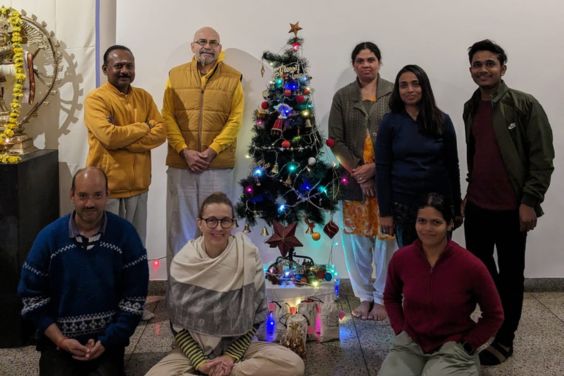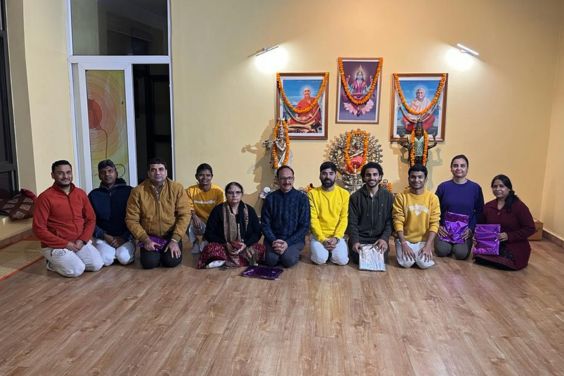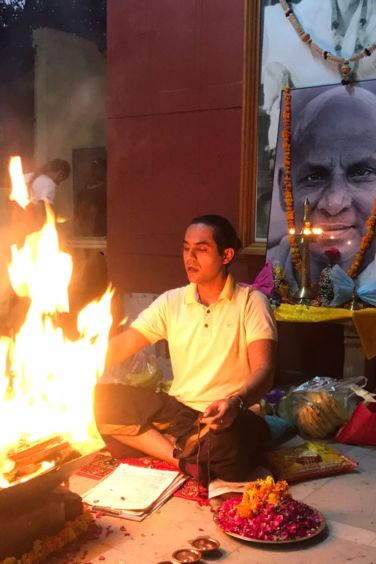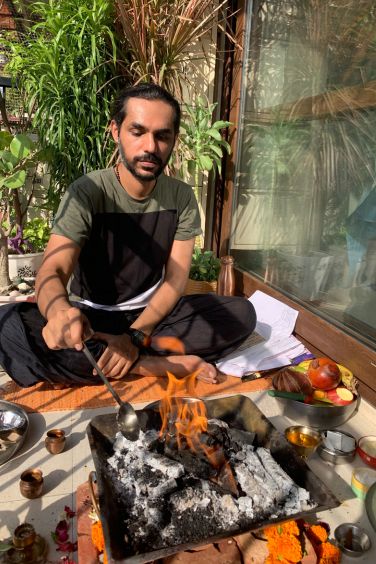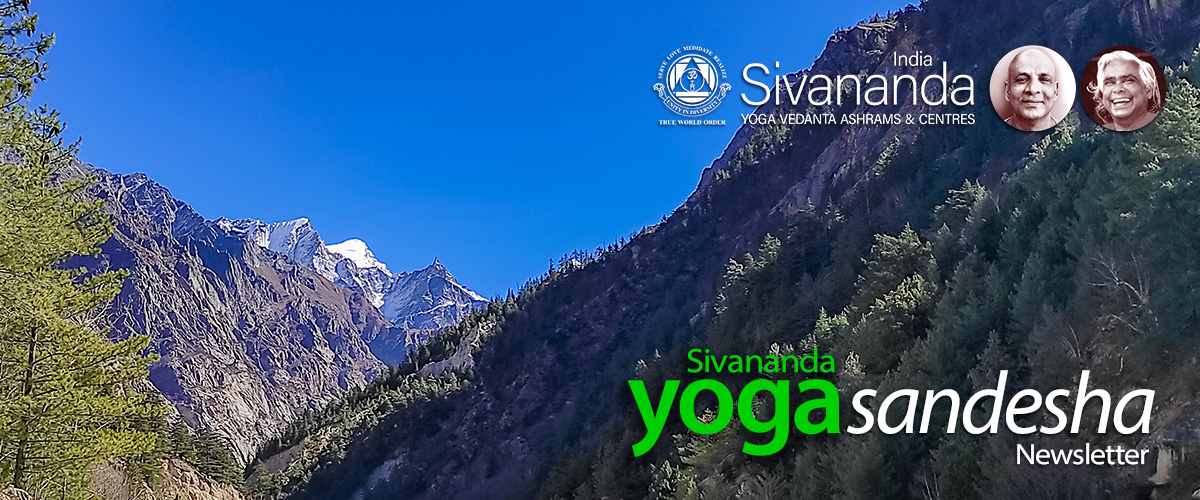
Om Namah Sivaya
Blessed Self,
As the year comes to a close and we approach a New Year, it is time to reflect on the past and to make concrete resolutions for the future.
Swami Vishnudevanandaji’s main objective for conducting charitable work around the globe was to bring health and peace to humanity through the ancient teachings and practice of yoga and meditation. Over the past year the number of people attending our locations in India and showing their appreciation of the teachings and discipline has grown. Swamiji reminded us that, “Guest is God, and without guests the ashrams and centres will not exist, and staff life is incomplete, without inspiration and motivation”. Guests motivate us to practice and, to maintain our locations as sattvic and welcoming locations, to offer the best to our students.
We continue Swamiji’s vision of helping the poor and needy. This year we helped to build and renovating homes, provide for education, medical, and marriage help to local staff, while also support local schools, hospitals, and the general public. By the grace of Master and Swamiji we have accomplished a few notable things this year.
Our activities would not be possible without the blessings and the grace of our Gurus and God. We remain also indebted to you, for your continued support, in making all this happen. As staff, we will continue to work hard to live up to your expectations and to impart the teachings of Master and Swamiji as purely as possible.
To download digital copies of the new Yoga Sandesha Magazine, and also the 2024 Sivananda India Calendar, follow these links!
We hope you have enjoyed a Merry Christmas and wish you a very Happy New Year ahead.
May Master and Swamiji’s blessings be with you always.
Pranams,
Sivananda Yoga Vedanta Ashrams & Centres, India
The first of the five Niyamas (or personal observances) described by Patanjali in the Yoga Sutra is Saucha, usually translated as purity or cleanliness. Generally, saucha is thought of first as an external cleanliness of the physical body and our environment.
When we examine cleanliness, the elements are invoked; fire and water play both ritual and symbolic roles in our understanding of purity and purification. Water cleans everything, and yet, fire refines and transforms anything it touches to its base component, removing everything that is not truly needed. Purification creates space and it creates quiet, the very things we need for mental purity.
Keeping the body clean also plays a ritual role. We must constantly repeat our actions of purification, creating patterns of purity within our lives. When our body and our environment are clean, the mind also becomes clear, our words, thoughts, and intentions reduced to what is beneficial. Within a clean space, we can more easily recognise any of our habits which are impure.
Cleanliness extends to diet, hygiene, decluttering our physical space (we’ve seen a renewed interest in this, thanks to Marie Kondo and others), relationships, and even our speech. All of the practices of hatha yoga help to purify in one way or another, similar to fire, removing what is not needed and channelling what : asanas purify both on the physical (organspranayamas purify the nadis (astral channels), mudras, and mantras.
In this issue of Yoga Sandesha we explore cleanliness of the home, the fire purification practice of Agnihotra, shoulder exercises to relieve stiffness and increase flexibility, clean eating, and why we should not remove sweat from the body after asana practice. Thank you for taking the time to read Yoga Sandesha. We hope you enjoy the newsletter and find some things to reflect upon. As usual, please feel free to reach out to us with your thoughts and feedback: [email protected]
Photo Update: Flooding Impact on Chennai Centre
Early in December, Chennai experienced heavy rainfall due to Cyclone Michaung. This resulted in severe flooding in parts of the city. The flooding did not spare our Centre in Kotivakkam. Here are a few photos of area residents swimming in the street and flooding to the lower level of our Centre. The flood waters have now subsided, however repairs are continuing to the building and electrical system are continuing.
News Update: Sivananda India’s Japan Tour
In December, Sivananda India’s Japan Tour was conducted with Prahladaji and with the support of Narayani, travelling to 11 locations: Ibaragi, Sendai, Iwate, Kanazawa, Hakuba, Nagano, Okinawa, Asagaya, Tokyo, Sizuoka, Himeji, and Fakuoka. Altogether, the Tour met with 288 students and karma yogis.
News Update: Christmas Celebrations at our Ashrams & Centres
Each of our Centres and Ashrams celebrated Christmas. Please enjoy these photos from celebrations at our locations across India.
Research/Links
Researchers from Indiana University have studied the relationship between cleaning and the interior condition of the home, and mental health, mood, and focus.
Read more here: www.news-medical.net/health/Investigating-the-Link-between-Cleaning-and-Mental-Health.aspx
The importance of hygiene and cleanliness in the scriptures of Hinduism.
Read more here: www.newindianexpress.com/cities/chennai/2014/oct/14/Hygiene-and-the-Hindu-Religion-671381.html
Spiritual Calendar
January 7 – Ekadasi
January 11 – New Moon
January 15 – Makara Sankranti
January 21 – Ekadasi
January 25 – Full Moon
Upcoming Courses:
Learn, Practise & Grow with Us!
Teachers’ Training Course (TTC)
- January 7 to February 3, 2024,
Neyyar Dam, Kerala
(English, with translation in Hindi, Malayalam, and Tamil) - Jan 14 to Feb 10, 2024,
Madurai, Tamil Nadu - Feb 11 to Mar 9, 2024,
Gudur, Andhra Pradesh - Feb 18 to Mar 16, 2024,
Madurai, Tamil Nadu
For more details, click here
Mindful Sadhana & Self-Development (ONLINE)
- Module 1: Physical,
Jan 15 – 20, 2024 - Module 2: Energetic,
Feb 12 – 17, 2024 - Module 3: Subtle,
Mar 11 – 16, 2024
For more details, click here
Sadhana Intensive Course (SI)
- January 21 to February 3, 2024,
Gudur, Andhra Pradesh
For more details, click here
Advanced Teachers’ Training Course (ATTC)
- February 11 to March 9, 2024,
Neyyar Dam, Kerala
For more details, click here
Teachings Excerpt:
Niyama and Saucha, by Swami Sivananda
The observances are (the practice of) internal and external purity, contentment, mortification, study of scriptures, and worship of God or self-surrender.
Niyama is the second accessory of Yoga. It is the practice of purity, contentment, mortification, study and worship. Patanjali Maharshi mentions these five observances under Niyama. According to Sandilya Rishi, Tapas, Santosha, Astikya, Dana, Isvara Pujana, Siddhanta Sravana, Hrih, Mati, Japa and Vrata come under Niyama. Through the practice of Krichara and Chandrayana Vratas, in accordance with Sastric injunctions, one purifies himself. His body gets emancipated. The sins are destroyed. The Indriyas are controlled. The passion-nature of the mind gets subdued. This is Tapas. Contentment with whatsoever one obtains of its own accord without effort is Santosha. Astikya is firm, unshakable belief in the existence of God, in the words of the Guru, in the truths inculcated in the Vedas and the merits or demerits of actions stated in the Vedas. Dana is the distribution of money, cloth, food, grains, etc., earned lawfully at the sweat of the brow, with faith, to deserving persons without expectation of fruits and without the idea of agency. Isvara Pujana is the worshipping of Lord Hari, Siva, Krishna or Rama with pure love, intense faith and single-minded devotion. Siddhanta Sravana is the enquiry into the right significance of Vedanta. It is the study and reflection of the nature of Brahman and the right significance of ‘Tat Tvam Asi’ Mahavakya. Hrih is the feeling of shame one experiences when he does certain actions which are not in accordance with the injunctions of the Vedas and rules of society. Mati is the faith in the paths prescribed by the Vedas for the attainment of God-consciousness or Self-realisation. Japa is the repetition of the Mantra into which one is duly initiated by the Guru or spiritual guide and which is not contrary to the rules of the Vedas. Vrata is the regular observance of or refraining from the actions prescribed or prohibited by the Vedas. The practice of Krichara, Chandrayana Vratas come under this heading. Krichara Vrata is fasting for 12 days. The observer of the Vrata drinks only some water. Many sins are destroyed by the practice of this Vrata.

Purification is of two kinds. They are internal (mental) and external (physical). Mental purity is more important. Physical purity is also needed. Cleanliness is next to godliness. The purity referred to here is physical or external purity. When the body is impure, one purifies it. Again it gets impure. Again he purifies it. He wants to keep the body always pure but it constantly gets impure. Gradually he gets disgust over the body which is full of impurities. Since the same dust and impurity is in the body of others, he ceases contact with others. Slowly the body idea drops as he always thinks of the ever pure Atman. Moha and Mamata for the body vanish. Lust disappears.
Teachings Excerpt:
Meditation and Mantras, by Swami Vishnudevananda
Aside from cleanliness, one should cultivate indifference toward the body. Cleanliness means internal as well as external purification. A proper diet based on vegetarianism and natural foods, specialized yogic cleansing techniques, and the Yoga exercises keep the body internally pure and free from obstructions. Cleanliness also extends to the mind. Only when it is purified of all dross can it be a pure mirror for the reflection of the Self.
YS 2, v. 41 Sattvasuddhi-saumanasyaikagryendriva-jayatma-darsana-yogyatvani ca.
From purification also come clarity of mind, cheerfulness, one-pointedness, control of the senses, and fitness, for realization of the Self.
From internal and external cleansing come all of the above, that is, a prevailing sense of sattwa, the quality of purity and light.
Practice and Teaching Tips:
Shoulder Exercises for Stiffness, Poor Posture, & Increasing Flexibility
You asked…and so here are some shoulder exercises! These will really help. They should be practiced slowly and take care not to push too much. Take your time, breathe, and enjoy!
Many people complain of shoulder stiffness, and sometimes pain. If you are a beginner to yoga, then you will likely be taught a couple of basic neck and shoulder exercises and then start to learn asanas such as Shoulderstand/Sarvangasana and Plough/Halasana, and eventually the Headstand/Sirshasana. During the learning process it is common to bear weight improperly at times, leading to more stiffness or even discomfort for a short time. These exercises will help.
If you are more experienced, but having difficulties with getting into advanced asanas (especially backward bends!) the same shoulder exercises can help to increase flexibility in the shoulders, and you might just be surprised at how that makes a difference.
Let’s explore shoulder exercises! Best wishes for your practice. Pranams.
Ayurveda/Yoga Tips:
Don’t Wipe Off Your Yoga-Induced Sweat!
In traditional ashrams during yoga class, teachers are often heard saying ‘Don’t wipe off your sweat, rub it back into your body to absorb the pranic energy that you just created’.
“The perspiration exuding from the exertion of practice should be rubbed into the body (and not wiped), as by so doing the body becomes strong.”
Hatha Yoga Pradipika, Chapter 2, verse 13

Hatha Yoga Pradipika, one of the traditional texts of yoga suggests rubbing the sweat created during a yoga practice, back into the skin. The text states that as the body begins to break out sweat, rub it immediately back into the skin to preserve vitality without the loss of prana. The text further states not to push the practice to the limits where the body perspires excessively. Excessive perspiration leads to loss of vitality (ojas).
Why do we sweat? Sweat is the water that the body releases when heated. Sweat contains small amounts of minerals, urea, and lactic acid. It is odourless. When sweat comes into contact with bacteria on the skin, it tends to smell a certain way. Sweat is a way for the body to regulate its temperature and when the sweat evaporates the body becomes cooler, making the blood cool down. Through circulation, the entire body cools down with the flowing blood. Both in the yogic understanding and scientifically, sweat is a means to detox the body and mind.
Importance of Sweat in Yoga: According to traditional texts, yoga is a process of purification of physical body, the nervous system, and the mind. Energetically, it is understood in yoga that heat cleanses the body. Just like heat is used to purify metals like gold and to remove its impurities. Yoga texts also suggest letting the body stay at the same temperature for some time after the practice. Heat for our body is the fuel that imparts warmth, and liveliness. It also makes us have the will to do things. This same warmth helps keep our body soft, supple, flexible and free-flowing.
Wiping off the sweat after a yoga practice is not recommended as it exposes the body to the coolness of the air. It cools down our inner system of its much-needed warmth. To keep the heat of the yoga practice in the body, it is recommended to rub the sweat back into the skin which helps create a protective layer on the skin surface and retain heat created with yogic practice. A yogi wants to preserve energy to preserve life force for higher endeavours, and rubbing sweat after the practice helps the cause.
Nutrition Tips:
Clean Eating for Yogis – Purpose & Tips
At the spiritual level yoga is the practice and process of one’s purification at different layers of being. The body is considered as a vehicle that leads one on this path of deep inner purification. Therefore, in yoga philosophy there is a huge importance given to keeping the body clean and preventing physical illness and breakdown, in order to attain spiritual awareness.
To keep the body internally clean, the importance of right foods cannot be ignored. Learning to eat clean must be a huge part of a yogic lifestyle. Clean eating simply means eating foods that are as close as possible to their natural state. The yogic definition of clean eating is conceptually a level up! The yogic diet considers the principles of Ahimsa, Sattva, and Prana as well. Ahimsa in the yogic context means “non-violence” and must reflect in a yogi’s food habits and choices. Ahimsa focuses on consuming a vegetarian diet while causing no harm to the animal kingdom. A yogic diet also emphasizes the principle of sattva and foods that are pure and light in quality, including fresh vegetables, grains, legumes, and mildly sweet foods. High prana foods keep the purity and energy high, which contributes to higher our spiritual pursuits.
The following guidelines provide a framework to begin clean eating on the yogic path:
- Give up sugary, refined, and processed foods: Refined, processed, sugar-laden foods can be addictive and increase the acidic load of the body, creating internal blockages and weakening the body of its defence mechanisms. A weak body cannot sustain the path of yoga for long.
- Consume foods which come directly from nature: A yogic diet places much emphasis on the prana or life-force of foods. Foods that come directly from nature are naturally high in prana. Generally, the fresher the produce, the more prana it contains. On the yogic path, on should consume more fresh fruits, vegetables, sprouts, green leafy vegetables, herbs, spices, beans, lentils, and wholegrains. Avoid frozen, stale, and packaged foods that are low in prana.
- Consume water to keep the system flowing and flexible: Yoga equates health and youth with flexibility. An inflexible body is a dry body and consuming enough water is a great way to keep the internal toxins moving and to keep the body hydrated and flexible. Drinking water first thing in the morning helps to flush out toxins.
- Consume wholegrains: Yoga practice requires energy and the best fuel to produce pure energy comes from carbohydrates. Wholegrains including millets, oats, wheat, quinoa, buckwheat, and amaranth are some of the best sources of clean energy.
- Modify diet according to the seasons: With changing seasons the body goes through a shift in its digestive capacity. It is important for a yogi to listen to these inner and outer clues to keep their body and digestion in a state of perfect health and well-being.
From the Community:
Deeper Significance of Saucha by Swami Krishnananda
Swami Krishnananda, a disciple of Swami Sivananda discusses the deeper significance of saucha, or purity and the importance of mental purity and our perspective or mental attitude. asanajournal.com/deeper-significance-saucha-purity/
From the Community:
Agnihotra – A Simple Fire Purification Practice, with Profound Impact, by Abhinav Chetan
Hello, I’m Abhinav Chetan, a digital marketer, a generative AI expert, and a yogi. My yoga journey started in 2010 at the Sivananda Dwarka Centre in Delhi and, of all the practices I’ve learned, few have resonated with me as deeply as Agnihotra. Today, I want to share this ancient ritual’s transformative power in my life and why I believe it’s a vital practice for our times.
My Introduction to Agnihotra: It was the first few weeks of covid in India and it coincided with Navaratri. We had decided to do a homa (fire ritual) but no priest would come home because of the countrywide lockdown. Left with no option, I decided to research, learn and do a homa myself. It was on the 1st of April 2020 that I performed the first homa in my house. It was Ashtami and also April Fool’s Day. I thought, who in their right mind would light a fire in their home and that too without any experience.
That was the beginning of a special journey into the fascinating world of homa. I started conducting homas regularly for various deities at home and at the Sivananda Yoga Centre. Every homa took a lot of time and energy to prepare, conduct and then wrap up. I also gradually started sharing my experiences with different mentors. One of them, a renowned Vedanta teacher, listened to my laments about the complexity of the practice an mentioned Agnihotra, which was much simpler and less time-consuming. Agnihotra is a Vedic ritual performed at sunrise and sunset and it intrigued me from the very start. It’s a simple practice and at the precise moments of sunrise and sunset, a small fire is lit in a copper vessel and specific offerings are made. When I first embarked on a 40-day Agnihotra Mandala, I didn’t expect the profound impact it would have. By the end, I felt a clarity and calm permeating my day. It was a certain alert, ever-present lightness that I hadn’t experienced before.
Challenges Along the Way: Like any practice worth doing, Agnihotra came with its challenges. The ritual’s timing is crucial, and initially, I struggled with getting it right. There were days when I couldn’t light the fire in time or it would extinguish before the right moment. But these challenges were part of the journey, teaching me the importance of patience and perseverance.
The Transformative Effects: Gradually, Agnihotra became more than a ritual, it became more of a habit which was a source of balance and peace. I found myself more present, grounded, and generally more connected whenever and wherever I performed it.
Sharing Agnihotra with Others: As I practised more Agnihotra a strong desire to share my learnings took root. Being an educator I’ve always wanted to understand all aspects of practices I took up. So after reading different books and researching homa and agnihotra, I built my own workshop titled ‘Firendship: Health, healing & harmony through fire’ where we discuss the importance of fire, its role in our evolution and talk about Agnihotra, focusing on its environmental and scientific aspects.
It’s always a revelation to learners how this simple practice can have such a profound impact – not just on the practitioner but on the environment too. Research shows that Agnihotra can improve air, water, and soil quality, making it a practice that benefits us and our entire ecosystem.
Learn more about the Firendship: Health, healing & harmony through fire workshop: abhinavchetan.com/firendship/
Why Agnihotra Matters Today: In today’s world, where environmental challenges loom large and personal peace seems elusive, Agnihotra offers great respite. It’s a practice that aligns us with the natural world, reminding us of our connection to the earth and the cosmos. Performing Agnihotra is a step towards healing ourselves and our planet. It’s a small act, but a powerful one.
I encourage everyone to explore Agnihotra. Whether you’re seeking inner peace, a deeper connection with nature, or a way to contribute positively to the environment, this practice offers a path. It’s a journey towards harmony and in these times, it’s more important than ever. Agnihotra is not just about lighting a fire, it’s about igniting a change within and without.
A link to a research paper on the benefits of Agnihotra:
www.researchgate.net/publication/273675026_Scientific_study_of_Vedic_Knowledge_Agnihotra
“Desire in the mind is the real impurity. Even a spark of desire is a very great evil. The real spiritual progress of the aspirant is measured by the extent to which he achieves inner tranquility. Practice meditation regularly.” -Swami Sivananda






